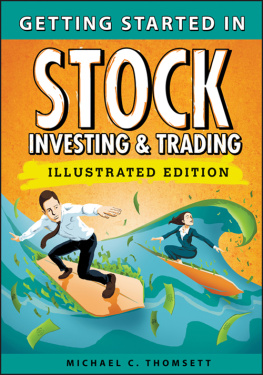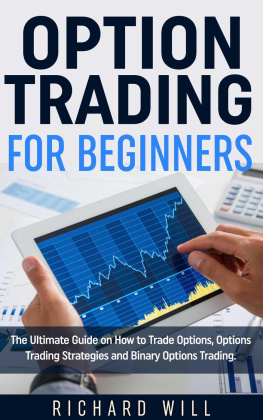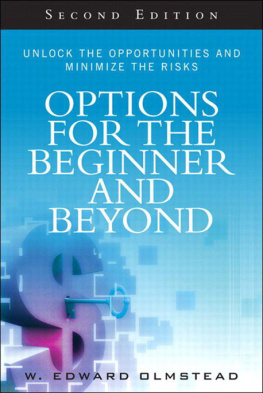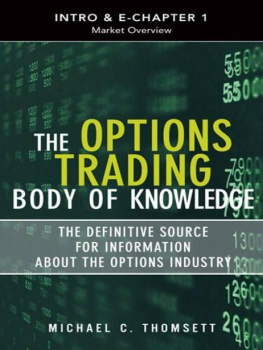Contents
GETTING STARTED IN
ADVANCED
OPTIONS
ILLUSTRATED EDITION
BOOKS IN THE GETTING STARTED IN SERIES
Getting Started in Currency Trading, Third Edition by Michael D. Archer
Getting Started in Forex Trading Strategies by Michael D. Archer
Getting Started in Asset Allocation by Bill Bresnan and Eric P. Gelb
Getting Started in Chart Patterns by Thomas N. Bulkowski
Getting Started in Internet Auctions by Alan Elliott
Getting Started in Mutual Funds, Second Edition by Alvin D. Hall
Getting Started in Stocks by Alvin D. Hall
Getting Started in Estate Planning by Kerry Hannon
Getting Started in a Financially Secure Retirement by Henry Hebeler
Getting Started in Online Personal Finance by Brad Hill
Getting Started in REITs by Richard Imperiale
Getting Started in Rebuilding Your 401(k), Second Edition by Paul Katzeff
Getting Started in Security Analysis by Peter J. Klein
Getting Started in Global Investing by Robert P. Kreitler
Getting Started in ETFs by Todd K. Lofton
Getting Started in Futures, Fifth Edition by Todd Lofton
Getting Started in Candlestick Charting by Tina Logan
Getting Started in Project Management by Paula Martin and Karen Tate
Getting Started in Value Investing by Charles Mizrahi
Getting Started in Financial Information by Daniel Moreau and Tracey Longo
Getting Started in Emerging Markets by Christopher Poillon
Getting Started in Technical Analysis by Jack D. Schwager
Getting Started in Hedge Funds, Third Edition by Daniel A. Strachman
Getting Started in Fundamental Analysis by Michael C. Thomsett
Getting Started in Options , Eighth Edition by Michael C. Thomsett
Getting Started in Options , Illustrated Edition by Michael C. Thomsett
Getting Started in Real Estate Investing, Third Edition by Michael C. Thomsett
Getting Started in Rental Income by Michael C. Thomsett
Getting Started in Six Sigma by Michael C. Thomsett
Getting Started in Stock Investing and Trading by Michael C. Thomsett
Getting Started in Stock Investing and Trading, Illustrated Edition by Michael C. Thomsett
Getting Started in Swing Trading by Michael C. Thomsett
Getting Started in Annuities by Gordon M. Williamson
Getting Started in Bonds, Second Edition by Sharon Saltzgiver Wright
Getting Started in Retirement Planning by Ronald M. Yolles and Murray Yolles

Copyright 2014 by Michael C. Thomsett.
Published by John Wiley & Sons Singapore Pte. Ltd.
1 Fusionopolis Walk, #07-01, Solaris South Tower, Singapore 138628
All rights reserved.
No part of this publication may be reproduced, stored in a retrieval system, or transmitted in any form or by any means, electronic, mechanical, photocopying, recording, scanning, or otherwise, except as expressly permitted by law, without either the prior written permission of the Publisher, or authorization through payment of the appropriate photocopy fee to the Copyright Clearance Center. Requests for permission should be addressed to the Publisher, John Wiley & Sons Singapore Pte. Ltd., 1 Fusionopolis Walk, #07-01, Solaris South Tower, Singapore 138628, tel: 65-6643-8000, fax: 65-6643-8008, e-mail: .
Limit of Liability/Disclaimer of Warranty: While the publisher and author have used their best efforts in preparing this book, they make no representations or warranties with respect to the accuracy or completeness of the contents of this book and specifically disclaim any implied warranties of merchantability or fitness for a particular purpose. No warranty may be created or extended by sales representatives or written sales materials. The advice and strategies contained herein may not be suitable for your situation. You should consult with a professional where appropriate. Neither the publisher nor the author shall be liable for any damages arising herefrom.
Other Wiley Editorial Offices
John Wiley & Sons, 111 River Street, Hoboken, NJ 07030, USA
John Wiley & Sons, The Atrium, Southern Gate, Chichester, West Sussex, P019 8SQ, United Kingdom
John Wiley& Sons (Canada) Ltd., 5353 Dundas Street West, Suite 400, Toronto, Ontario, M9B 6HB, Canada
John Wiley& Sons Australia Ltd., 42 McDougall Street, Milton, Queensland 4064, Australia
Wiley-VCH, Boschstrasse 12, D-69469 Weinheim, Germany
Library of Congress Cataloging-in-Publication Data:
ISBN 978-1-118-34363-0 (Paperback)
ISBN 978-1-118-34369-2 (ePDF)
ISBN 978-1-118-34368-5 (ePub)
ACKNOWLEDGMENTS
Thanks to those many readers who wrote to offer their suggestions for and insights into previous editions of Getting Started in Options , including constructive criticism and clarifying questions. Their letters have helped to improve the ever-changing set of explanations and examples, definitions, and other materials used in this book.
Very special thanks go to Debra Englander, my editor for many years at John Wiley & Sons, whose encouragement through many editions of this and other books has been greatly appreciated.
Also, many thanks to Nick Wallwork and Gemma Rosey, my editors in Singapore, for their excellent help and guidance through the production process.
ELEMENT KEY
 | Definitions
This symbol is found in boxed notations providing specific definitions of options terms. These are placed within the book to accompany and augment discussions relevant to each definition. |
 | Key Points
These highlighted sections emphasize key points or offer observations, rules of thumb, and added points that options traders can use. |
 | Valuable Resources
These sections provide links to websites where you will find added value for particular options discussions, to further help in expanding your options knowledge base. |
 | Examples
Numerous examples illustrate points raised in context and provide a view of how the issues might apply using actual options trades. They are intended to demonstrate practical application of the principles being presented. |
INTRODUCTION
Every investor and trader wants to combine several attributes in the stock portfolio: diversification, leverage, safety, and profitability.
This is a big order. How can you create all of these elements in the same portfolio? Tradition advises that if you want profits, you have to give up safety, and that if you want to use leverage, you have to take on greater risk.
In this book, these traditional problems are challenged by demonstrating how to combine the desirable attributes while managing and even eliminating the undesirable ones.
Options, once reserved for speculators and those able to tolerate high risk, have become mainstream devices for portfolio management. Many advanced option strategies can be applied so that risks are held down or even hedged entirely, while even conservative investors may create profits by combining options with stock positions.
Can options be used in a conservative manner? Yes; in fact, one of the best aspects to this market is that it can be designed to fit a range of risk tolerance profiles. The highly conservative investor may use options to reduce risk in long stock positions. On the far end of the spectrum, the speculator can continue to use options to swing trade, leverage, and seek fast profits. The range of strategies covers the entire risk spectrum.
Next page













